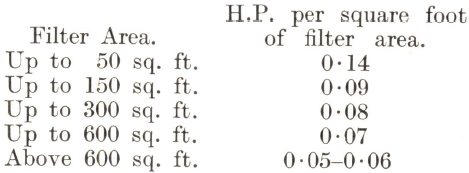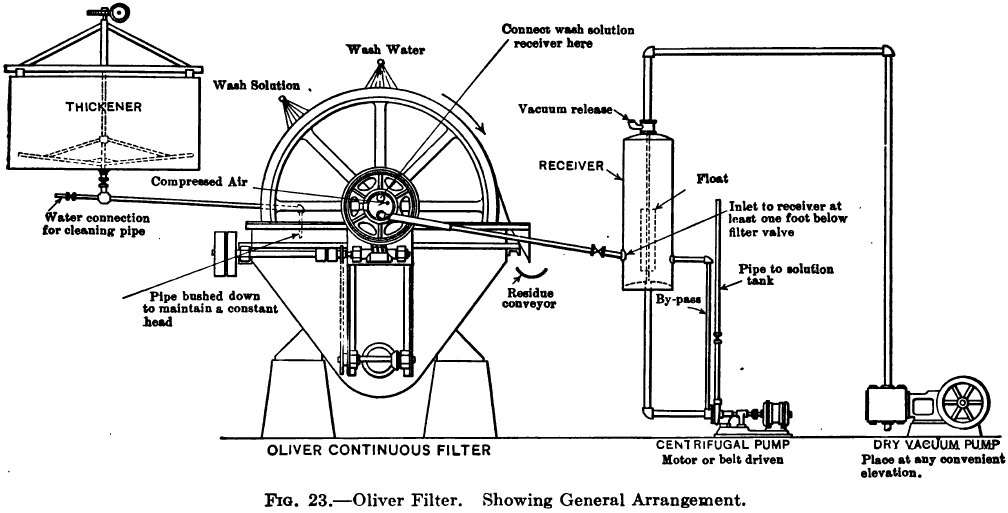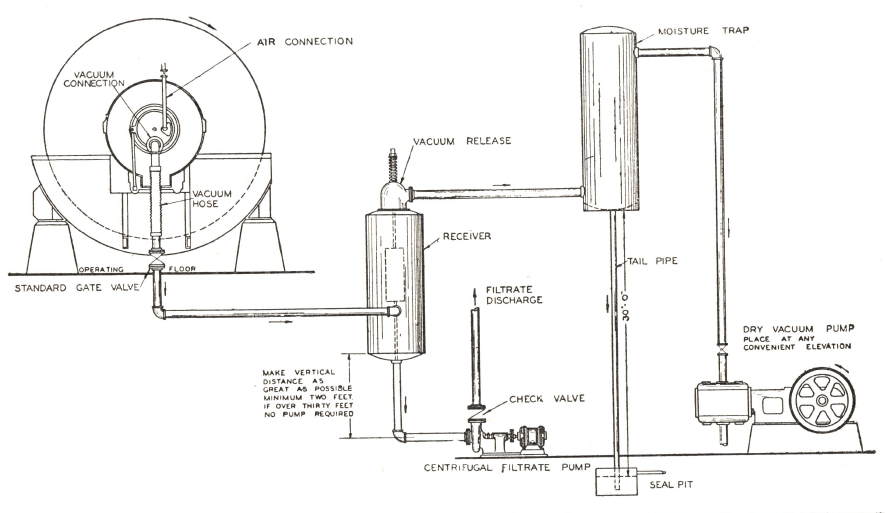Table of Contents
The capacity of a vacuum rotary drum filter varies from about 200 to 2,000 lb. of dry concentrate per square foot of filtering surface per 24 hours according to the nature of the material and the amount of water that it contains. For the purposes of rough calculations it is usual to assume a capacity of 1,000 lb. per square foot, although this figure is generally exceeded under modern conditions. The moisture in the discharged cake normally ranges from 8 to 12%.
Choosing a Rotary Disk or Rotary Drum Filter
The rotary disk filter is the only type capable of handling two concentrates in one machine, the vertical disc construction making it possible for the tank to be partitioned and each half used for a different product. It also occupies less floor space per unit of filtering area than the other two.
The formation of the cake is not so uniform in a rotary disk filter as in an drum filter nor does the water drain so evenly. In the latter machine, directly a compartment has risen to the level of the axis of the drum, the water drains straight out of the cake by gravity. In a Rotary Drum Filter any water left in the cake after a compartment has risen above the level of the axis of the drum tends to drain by gravity back into the cake, which is then dried solely by the current of air drawn through by the vacuum pump. This does not occur, however, when the concentrate contains a large proportion of coarse or granular material, since the porous structure of the cake makes filtering unusually rapid. For this class of material the drum filter is therefore very suitable, but, for handling a product with much slime which does not filter so readily, it is more satisfactory to employ an Oliver or an rotary disk filter . There is little to choose between the two when considerations of floor space do not make the latter type preferable. The disadvantage of the drum filter is that replacement of the cloth is a lengthy operation as compared with the rapid change possible with an rotary disk filter , but this is compensated by the fact that the wire winding round the drum protects the fabric from extensive damage. Should a small tear develop, it can be readily repaired by tacking a patch over it, which method is not practicable with a filter bag.
Rotary Filter System Installation
The arrangement of a filter installation is shown diagrammatically. Since a dry vacuum pump is the most satisfactory type to use, a moisture trap is necessary ahead of the pump to ensure that no water is drawn into the cylinder. Drainage of water from the trap is effected either by means of a barometric leg and seal pit, or, where the elevation of the trap does not permit of this arrangement, by running a connecting pipe from the bottom of the trap through a non-return valve to the bottom of the vacuum receiver. When a barometric leg is employed, the volume of the seal pit or sump must be greater than that of the pipe forming the barometric leg in order to prevent air from being drawn into the vacuum system.
The vacuum pump most commonly used is of the reciprocating type with a horizontal cylinder, either single or duplex, the pump being equipped with light quick-acting valves interchangeable for inlet or discharge. A leaf and spring construction of the valves permits a certain amount of moisture to enter the cylinder without damage to the pump. For normal purposes it is usual to allow one cubic foot of vacuum pump displacement per minute per square foot of filter area.
The filtrate is collected in a large receiver, from which it must be pumped or drained as fast as it enters. When a pump is employed, it should be of the centrifugal type, designed to operate against a suction lift of 25-30 ft., since the inlet is under a vacuum equivalent to a column of water of that height. Should a vertical drop of 30 ft. or more be available below the level of the bottom of the receiver tank, a barometric leg can be substituted. The water then drains by gravity from the receiver into a suitable sump.
The amount of air required for loosening the filter cake at the discharge point is about 1/5 cu. ft. per minute per square foot of filter area at 10 lb. per square inch pressure for the drum filter, 1/10 cu ft. at ½-1 lb. pressure for the rotary disk filter , and 1/6 cu. ft. at 4 lb. pressure for the drum filter. A small reciprocating compressor or rotary blower is usually employed. In the case of the drum filter a receiver is placed between the compressor and the filter, but with the other two types the blower is situated close to the filter and connected to it with a pipe of reasonably large diameter.
The power requirements of complete filter installations of various capacities are as follows:

Types of Rotary Filters
The second step in the dewatering of the concentrates, that of bringing them down to about 10% moisture, can be done most cheaply in filters of the vacuum type. There are three machines in common use, the Oliver Drum Filter, the American Disc Filter, and the Dorrco Filter.


